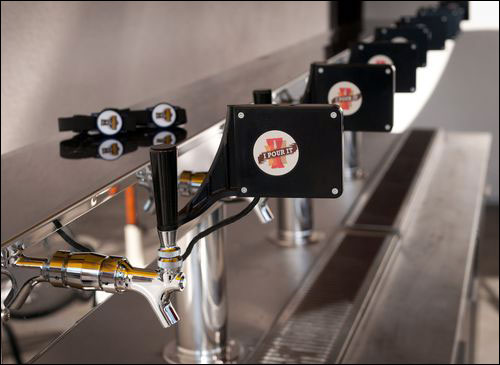Oct 22, 2012TapHouse HB, located in Huntington Beach, Calif., is employing a new RFID-enabled beer tap solution provided by iPourIt to allow customers to pour their own beer. The system tracks consumption and provides details for each patron's tab at the end of the night, as well as cutting off any customer who reaches a maximum permitted quantity. TapHouse is the first business to use what the technology's developers hope will become a Web-based self-serve system that will be utilized at many bars and restaurants, enabling patrons to receive discounts or promotions based on personal own drink preferences.
The inspiration for iPourIt, says Joseph McCarthy, the company's CEO and cofounder, came about at a sports bar where he and a friend, Brett Jones (now the firm's CTO), went to have a beer. The two waited a long time before someone came to take their order, and an even greater period passed before the server returned to tell them the beer they had requested was not available. Jones, then the CTO of an international cruise line, and McCarthy, who served as that company's general counsel and VP of mergers and acquisitions, began thinking about a solution.
The result was an RFID-based pouring system that Jones and McCarthy began beta-testing in 2011, which they commercialized approximately six months ago. The solution features iPourIt beer taps, each with its own StrongLink SL018 Mifare RFID reader. The taps are activated by RFID-enabled wristbands worn by patrons.
Although there are other RFID-based beer-pouring solutions available on the market (see Wall of Beer Lets Patrons Draw Their Drinks), the iPourIt system is different, McCarthy says, because it is designed to store customer data on a hosted server in order to benefit both patrons and the business. With iPourIt, a customer can set up an ID number that he or she could then use at any participating businesses, and then receive coupons or alerts about upcoming beer-tasting events, as well as reserve a new specialty brew from a limited supply. "The technology ties back to a database, and each person is uniquely identified," explains McCarthy, which he says "provides enhanced customer service."
In August 2012, TapHouse HB installed eight RFID-enabled beer taps, each for a different type of beer. Upon arriving, a patron provides his or her driver's license, along with the credit card on which that person will be paying for drinks. This information is entered into the iPourIt system, along with the unique ID number encoded to a 13.56 MHz NXP Semiconductors Mifare RFID chip built into a wristband provided to that customer. The individual is then assigned an iPourIt ID that is linked to the wristband's RFID number, but can also be used at later time with a different RFID tag.
When the patron is ready to pay the tab, a worker reads the wristband tag at a point-of-sale terminal, views the total beer cost and bills the credit card accordingly. The individual then returns the wristband, so that it can be used by a subsequent patron. The next time the customer returns to that business, or visits another participating establishment, he or she can again provide the driver's license, to be scanned into the iPourIt system. The Web-based iPourIt software application retrieves that individual's customer ID number and beer-drinking history, and can suggest beer promotions based on previous brand or beer-type preferences.
The system could support other functions as well, McCarthy says,, such as the ability to send messages to users via cell phone, based on their beer preferences. Although TapHouse HB is not yet using this functionality, businesses could choose to send promotions to an individual who has opted to provide a mobile phone number or e-mail address to receive such messages. For example, if a keg or a special brew is expected to become available at the restaurant, the iPourIt software can notify drinkers of that kind of beer, and offer to reserve a glass from the keg. A user can then utilize a phone, tablet or laptop to log into the iPourIt Web site and reserve, for example, 20 ounces.
The iPourIt system would then ensure that the reserved quantity of beer was available during the time of that patron's visit, by shutting off the valve once a keg neared the minimum reserved amount.
Businesses pay a service charge to iPourIt, based on the number of ounces poured. For bar and restaurant owners, McCarthy says, the system reduces shrinkage (he notes that 23 to 27 percent of tap beer is never charged, mostly due to over-pours) and offers enhanced customer service. This, he says, makes it easier for individuals to access the beer, and to draw the exact amount they want of each type, until reaching their limit. The software can also issue alerts to management if a keg will soon be empty. According to McCarthy, iPourIt is presently in discussions with two "nationally recognized" food service chains that are interested in adopting the system.


